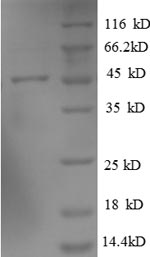The region for expressing recombinant Human ARL2BP contains amino acids 1-163. The theoretical molecular weight of the ARL2BP protein is 45.8 kDa. The ARL2BP protein was expressed in e.coli. The N-terminal GST tag was fused into the coding gene segment of ARL2BP, making it easier to detect and purify the ARL2BP recombinant protein in the later stages of expression and purification.
The human ADP-ribosylation factor-like protein 2-binding protein (ARL2BP) is a protein that interacts with ARL2, an ADP-ribosylation factor-like protein involved in intracellular vesicle trafficking. ARL2BP has been implicated in processes related to cellular organization and vesicle transport. It may play a role in microtubule dynamics and centrosome function. Research on ARL2BP aims to uncover its specific cellular functions, interactions with ARL2, and its potential involvement in cellular processes critical for overall cell function and organization.






